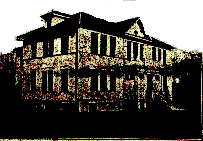Santee History
SANTEE NORMAL TRAINING SCHOOL
|
|
 |
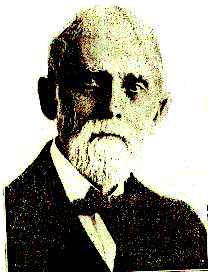 |
|
Memorial Hall, classrooms |
Bird's Nest, a girl's dormitory | Alfred L. Riggs, Founder |
The Santee Normal Training School was founded by Alfred L. Riggs, an American Board member, in an attempt to train native teachers. As a boarding school, established in the winter of 1870-1871, it had an enrollment of 111 and an average attendance of 69. From 1870-1923, the school had 2,398 pupils on the roll. After 67 years, the school closed in 1937.
The Santee Normal Training School reached its high point in the 1890's, when it became in reality what its founder had envisioned it as being: a center of education for all the Sioux. Financial support from the government and religious societies were a mixed blessing. Besides its financial support the government tried to control what was taught at the school. For example, Riggs was constantly defending usage of the Dakota language while teaching. In 1886-7, he was ordered by the government to teach only in the English language. In Riggs' official report he pointed out that in the normal department of the school the use of Dakota was "indispensable to the best instruction." "Things, not names," he said, "are what the true teacher must grasp; then names come afterwards." He went on to further point out that the Santee Normal Training School represents "the high water mark of Indian advance more than any other school in the country." He reviewed its history and described its impressive physical plant, concluding: "And now this is to be dismembered and eviscerated by the order of the government."
In 1893, the strain of trying to accommodate the school and the government proved too great. The government contract was terminated and the American Missionary Association, a Congregational body, operated the school until the fourth decade of the twentieth century.

Despite the promise held by the Santee Normal Training School, government officials continued to recommend the establishment of a manual labor school at the Santee agency. Reasons for opening a school for the Santee included the separation of church and state and of (the then current) beliefs about the best way to lead the Indians to civilization. There was a strong prejudice among Indian Bureau officials against conducting any education in the Indians' native language. It wasn't until 1934 that the Indian Bureau realized that the eradication of the Indian's native language was not necessary in the learning process.
In 1874, a Santee Industrial School was completed. It opened with thirty-six students and three teachers. The students found the physical conditions of school life more comfortable, particularly after the brick building was finished, than life in the ill-heated log houses in which most of their families lived. Whether this comparative luxury compensated for the rigid discipline imposed by the school authorities and the absence of parental affection is another question. Due to the presence of the Santee Normal Training School and a number of district schools on the reservation, and the fact that the plant was in poor shape and "not well thought of by the Indians," the boarding school closed in 1909.

While the Santee Normal Training School and the Santee Industrial School were running their hectic course, there were mission schools that also proceeded steadily with their work. The Episcopal Church ran three-day schools and a girls' boarding school for a number of years, and about 1882 opened Hope School, a small institution for boys across the river at Springfield, Dakota Territory. After the burning of the mission buildings at Santee in 1884, the girls' school, St. Mary's, was closed and reestablished the following year at Springfield. These church schools were later consolidated. At the beginning of 1896, the churches rented the institution to the government, which, in turn, was conducted as a school for about fifty boys.

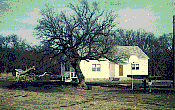 |
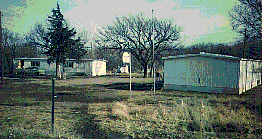 |
| The main office, library, and multipurpose room were housed in this building. | The kitchen, kindergarten, first & second grades were housed in the east building. The south building housed the third-sixth grades. |
Although the aforementioned schools were served by district schools for many years, the Indian people yearned for their own school, which could follow a curriculum more suited to their children's needs.
That yearning was met shortly before the opening of the new school building, where classes were being held in what was known as the C-5 District School which was made up of only one building and two doublewide trailers. At first, the one building was enough to house the students. However, the extra buildings became necessary when the school's population increased due to the construction of many new houses in Santee. In the fall of 1971, the school consisted of 12 students supervised by one teacher and a cook. A year later, the school consisted of 80 students that filled the buildings and 15 staff members.

SANTEE COMMUNITY SCHOOL (previously known as Santee Public School)
The Indian people's wishes were finally realized in 1976, when a school was built at Santee. At first limited to kindergarten through eighth grade, it subsequently added a four-year high school. It was financed by a $2.1 million federal grant. Although the school is of the most modern design, with sky lights and carpeting, the traditions and heritage of the Santee have not been forgotten. A mural in the school (pictured below) depicts the history of the Santee:
|
The history of the Santee tribe is shown on a wall mural as one enters the school. Artist Tom Kronen of Omaha used brilliant colors to span the era from sylvan days before the white man came to the "ill-famed Minnesota Massacre," and public hangings of the Santee before the survivors were driven from their homes. The bleakness of a winter trek to a new home in Nebraska blends with the hope of the future as a modern Santee youth sits with a book in hand, looking back over history. |
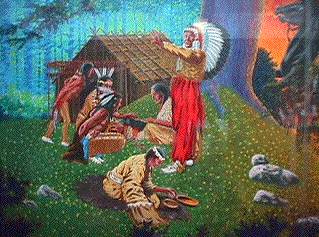 |
Today, the Santee Community School has an enrollment of 145 students, with a ninety-eight percent Native American population. There is one administrator, twenty-three certified teachers, and sixteen classified staff members. The curriculum offers a variety of classes ranging from the basic math, English, and Social Studies classes to Industrial Technology and computer classes. Every other year a class in Santee History is offered to the junior and senior classes. All of the students are involved with various other cultural activities throughout the school year with the school's Culture Club.
Information for this page has been obtained from:
Meyer, Roy W. History of the Santee Sioux. University of Nebraska Press, 1993.
Niobrara Tribune, Issues, December 1975 and May 1976.
Niobrara Historical Museum


